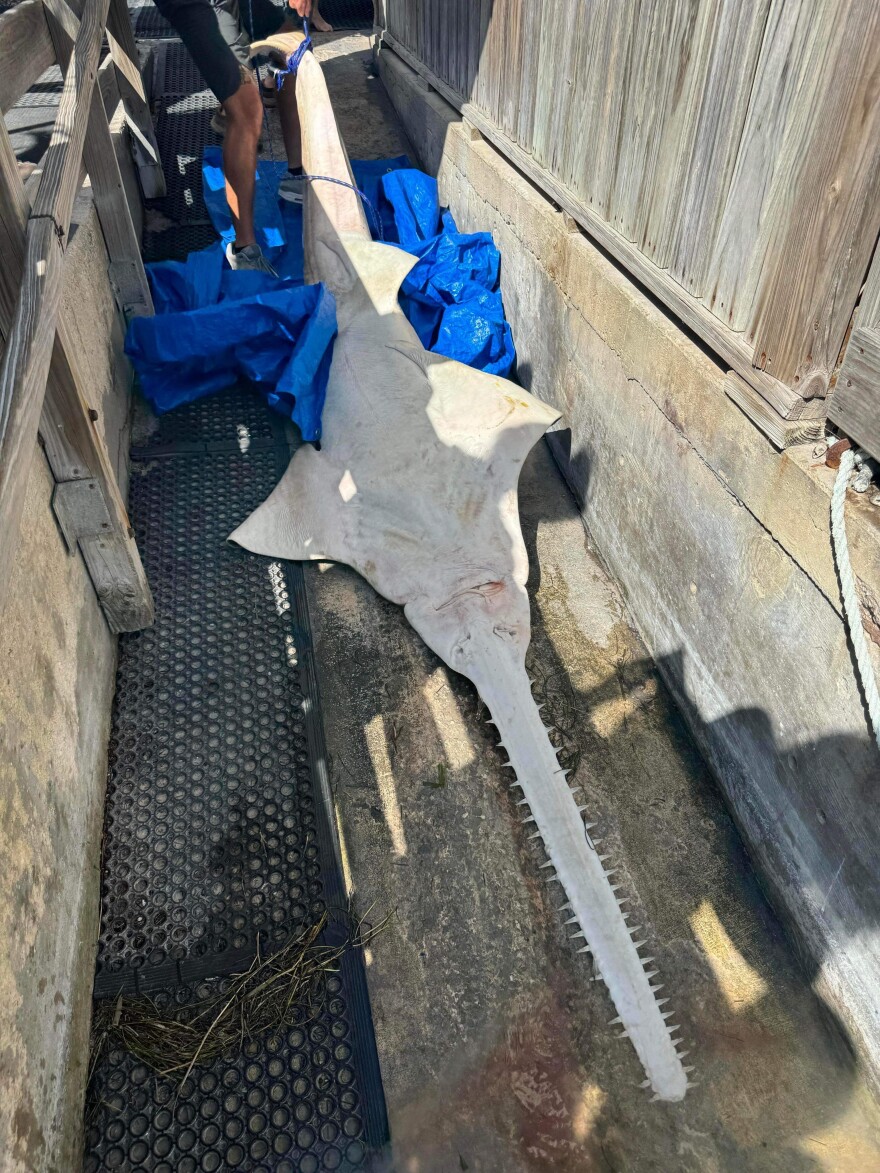The number of rare dead sawfish in the Florida Keys continues to rise, reaching 40 this week, as a rescued fish pulled from waters off Cudjoe Key earlier this month recovers under veterinary care.
Florida wildlife officials said Tuesday the number of other affected species now includes more than 50, in mostly near shore waters.
Among those reported in distress are baitfish spinning in circles, Goliath grouper struggling to stay upright and snook thrashing in water, along with dead tarpon and sharks. Lower Keys residents say the number is likely higher.
The latest update, provided during an advisory council meeting for the Florida Keys National Marine Sanctuary, painted a gloomy picture: so far the cause remains unknown.
But officials say the rescued sawfish being cared for at a Mote Marine Lab rehab facility — along with early experiments on healthy fish exposed to tainted water from the Lower Keys — could be a sign of hope. Fish begin to show signs of distress after just 20 minutes in tainted water. But once removed, they appear to recuperate.
“Ongoing studies suggest that recovery is possible for some of these species,” said Christopher “CJ” Sweetman, the Florida Fish and Wildlife Conservation Commission’s federal fisheries section leader. “So it’s not all doom and gloom here.”
Fishing guides first began spotting the distressed fish in November and contacted the nonprofit Bonefish Tarpon Trust (BTT) to document cases. Then in late January, an endangered smalltooth sawfish turned up dead near Geiger Key, setting off alarms.

The death was unusual because sightings of sawfish, which can grow to 16 feet with a toothy rostrum making up a third of their body length, are rare. They mostly live on the muddy bottom in deeper waters.
In the months since, a study group organized by BTT — including toxicologists from the Florida Gulf Coast University, the University of South Alabama and Florida International University, as well as state and federal officials — have searched for clues. Scientists quickly ruled out low oxygen, high temperatures and red tide — usual suspects in fish kills. Common pollutants also got ruled out.
“Basically, we have tested for every human-made chemical pollutant that we can,” said Nick Parr with the Florida Department of Environmental Protection. “It does not appear that what is affecting the fish directly is of human origin.”
To be sure, Parr said FDEP scientists are exposing healthy juvenile fish to water from the Lower Keys to make sure they’re not missing a more subtle pollutant.
“This is a method that has been well developed in testing wastewater effluent to make sure that it’s not there’s not something toxic in there,” he said.
So far the most likely culprits are toxic tiny algae, called dinoflagellates. Scientists have already confirmed the presence of several and are now trying to determine if a single toxin, or a combination, may be the cause. However, teasing out the toxin found in fish and toxin found in water is difficult.
The summer heat wave could also play a role. Algae react differently to temperature. And the summer heat wave turned temperatures in the ocean upside down, with waters near the bottom warmer while upper waters remained cooler. That reverse thermo incline could have allowed toxic dinoflagellates that prefer cooler water to spread. In an attempt to better understand how temperature affects sea life, including coral and sponges, the sanctuary is installing additional monitors purchased by the Marine Preservation Society of the Lower Keys.
Last month, with the number of dead sawfish at 29, the National Oceanic and Atmospheric Administration announced it was going to begin trying to rescue the fish, an unprecedented step hinting at the deepening concern.
On Tuesday, Parr said officials also plan to begin testing water for metal that could be sickening fish, even if it’s an unlikely cause.
“We don’t think it’s metals,” he said. “Metals don’t tend to stay suspended in the water column. But we’re running out of ideas.”

Jenny Staletovich
Jenny Staletovich is WLRN's Environmental Reporter. Her work appears under a partnership between WLRN and the Key Biscayne Independent.


